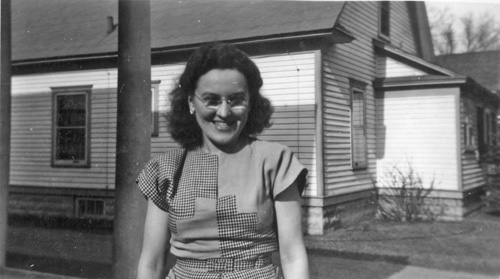We Can Do It! Women Railroaders During World War II
(Part 1/11)
World War II began when Hitler's army invaded Poland on September 1, 1939. However, it wasn't until the day after the Japanese attacked Pearl Harbor on December 7, 1941, that the United States declared war on the Axis Powers.
The railroads immediately were called upon to transport troops and equipment heading overseas. Soon the efforts increased to supporting war efforts on two fronts-- in Europe and in the Pacific.
(Part 2/11)
Prior to the 1940s, the few women employed by the railroads were either advertising models, or were responsible primarily for cleaning and clerical work. Thanks to the war, the number of female railroad employees rose rapidly.
One of the new workers was Irene Friesen.
(Part 3/11)
Irene started her railroad career in Gibbon, Nebraska, as a telegrapher. She quickly worked her way up the ladder to the role of station agent in Elba, Nebraska.
"It was a little unusual to have a girl depot agent. But in the town of Elba, women had most of the important jobs," Irene wrote in her diary. "We even had a woman minister at one of the churches in town. There was a war on, so the men were at war."
(Part 4/11)
After hopping around to several Nebraska towns, Irene earned a steady job in Gibbon, Nebraska. "There was a lot of business in Gibbon, so there was no need to carry a lunch. You didn't usually get to eat it," Friesen wrote. "We worked seven days a week every week. Days off were hard to come by. There were very few operators qualified for the interlocking plant and a large pile of telegraphing to do. I was having trouble with my arms, so I asked for some time off. The answer was no, because there was no one available to release me. So I bid on a job in Grand Island."
(Part 5/11)
Irene was hired as a night telegrapher in Grand Island, Nebraska, and made it her home. "It was not the busy job I had at Gibbon, so I got by ok. I slept during the day."
(Part 6/11)
Irene was startled awake by a man named Mac Bosler on the afternoon of May 8. "He told me the war was over. People went crazy! Everyone went out in the streets," Irene wrote. "They were all cheering, 'The boys are coming home!' I was having a hard time with my arms that day, but I was out there too."
(Part 7/11)
The number of women employees working for the railroads dropped off as the war came to a close. However, because the total number of workers also declined, the percentage of women employed by the railroads rose to 8.2 percent.
(Part 8/11)
Irene eventually earned the position of night dispatcher at the Grand Island tower.
Dale Frisen walked into Irene's life in the fall of 1945. She was told to "break in" Dale so he could work as her daytime counterpart. "Dale was doing quite well, and it left me with nothing to do," wrote Irene. "I got out my crocheting supplies, which is what I did to stay awake and alert for signals. I was making a three piece buffet set for my mother. Dale bet me a malted milk that I couldn't finish the first spool of yarn. Of course, he knew I would, and he lost the bet. That was our first date."
(Part 9/11)
Irene and Dale went on to get married on September 16, 1946, in Defiance, Iowa, at St. Peter's Church. "We spent a couple days in Chicago, Illinois, Rochester, Indiana and Topeka, Kansas, to meet Dale's folks. We had to report back to work before the end of September so as to not miss a pay period," she wrote.
(Part 10/11)
Toward the end of 1946, Irene's dispatching job was taken by a man named Herman Miller, so she returned to telegraphing. She writes, "He was a Veteran, so I didn't fight it." After Dale got a dispatching job in Omaha, Nebraska, Irene quit working for the railroad because traveling between Grand Island, Nebraska, and Omaha, Nebraska, became too much.
(Part 11/11)
Irene and women like her forged a path for thousands of women who work for railroads in the United States today. Replacing men with women in the workplace during World War II changed our country's perception of women and the types of work they should be doing. After the war, women continued to be employed as telegraphers, yardmen, shop workers and trainmen.

